| 1 | Nigeria’s most dangerous snake |
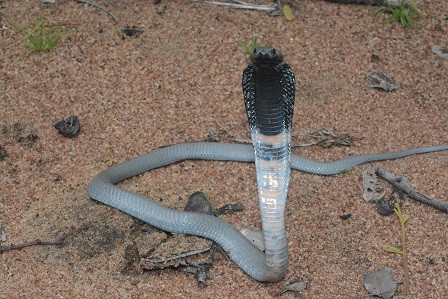
In Nigeria, everyone knows that a jet black snake with no patterns measuring approximately 1.5 metres is sufficient reason to turn around and run as far as you can, instantly. That’s because Nigeria is home to the black-necked spitting cobra (Naja nigricinta), a species which not only has a lethal bite, but the ability to spit potent globules of venom in people’s eyes.
The black-necked spitting cobra dominates western Africa, but is also the most widespread spitting cobra in the entire African continent. This species is in full control of Nigeria, Ghana, Ivory Coast, Togo, and Sierra Leone alike. Further east, they’re found in Uganda, Rwanda, and even non-rainforest portions of the DRC (as they never appear inside rainforests). Their easternmost extent is a small pocket inside Ethiopia, while to the far west, they inhabit Gambia and Senegal bordering the Atlantic ocean.
This species is one of two main cobras found in Nigeria, Togo, Benin, etc. However, the black-necked spitting cobra is much more common in towns and human zones than the forest cobra (Naja melanoleuca), which is larger, but lacks the ability to spit.
In most of its countries, the black-necked spitting cobra is very common, a snake that you’re highly likely to bump into while minding your own business, especially in villages and farmland.
| 2 | Can spit 57 times in 20 minutes |
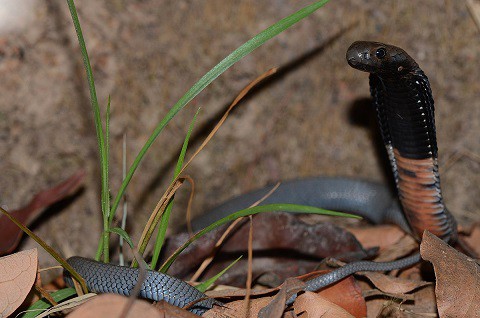
Unlike the ball python, which ancient kings used to drape proudly around their necks, the black-necked spitting cobra isn’t very popular across its wide central African range. When you think about it, it’s not hard to work out why: this is a snake which can spit corrosive venom in people’s eyes with extreme accuracy from 3 metres away. This species is not just aggressive, but has the hair-raising ability to spit 57 times in 20 minutes.
Unlike the red spitting cobra, black-necks usually spray in a fine mist rather than dual thin jets. But they still manage to strike the eyes with extreme precision, and it’s always the eyes they go for, as the goal is blinding potential predators, with the bite reserved for disabling small prey.
Black-necked spitting cobras kill relatively few people. Bites aren’t massively common, and the mortality rate is only 5-10%, but it’s the unpredictable flying jets of venom which inspire so much fear among Nigerian and Ghanaian locals. Though unconfirmed, there are reports of accurate shots from 7 metres away.
| 3 | Completely numb eyeballs |
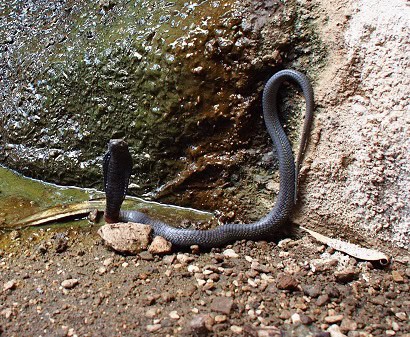
The Mozambique spitting cobra (southern Africa’s version) has the terrifying advantage of constantly entering people’s bedrooms, but Naja nigricollis boasts a slightly higher venom yield, of 9.75mg per spit versus 8.34mg. The red spitting cobra is even further behind at 2.64mg.
One unusual effect was documented in 1940 in the case of 30 year old Gogi Kusasi, a Ghanaian farmer. He was cutting long grass with a scythe one day when a snake raised its head up from tussocks 4-5 feet away. It instantly spat a torrent of venom in his eye, and 20 minutes later Kusasi staggered into a British medical hospital, where the dead (now decapitated) snake was confirmed as a black-necked spitting cobra. By now, Kusasi’s right eyeball was badly swollen, and even starting to become opaque.
The doctors noticed how the venom failed to diffuse into the body, remaining in the eyeball which the cobra had instinctively targeted. But the most unexpected symptom was that for 3-5 days, Kusasi’s eyeball became completely numb. It was so numb that the doctors could dab a cleansing cotton wool on it without any discomfort. By day 9, Kusasi had completely recovered, with pain gone and his vision intact.
| 4 | Aims directly for the eyes |
In a groundbreaking study from 2005, scientists unearthed several tricks of the spitting cobra trade. Despite nonstop insistence from Africans and western explorers, nobody had actually proven that spitting cobras went for the eyes at this point. So Katja Tzschätzsch from the University of Bonn strapped on a transparent pair of goggles and wilfully entered an enclosure where 6 black-necked spitting cobras and 4 red spitters were waiting. A high quality video camera was used to record the results.
One by one, the cobras reacted to a moving face, with not one reacting to a moving hand. The cobras aimed for the eyes, and brave Tzschätzsch had venom dripping off her goggles by the end.
She also pinned up photos of human faces, and only 2 were sprayed, proving that spitting cobras require a living, breathing predator to activate properly. In those cases though, they went for the eyes once again. Their accuracy was high, as the black-necks struck the eye area on the goggles 8 times out of ten. The red spitting cobras struck the eyes every time.
| 5 | The blackest African cobra |
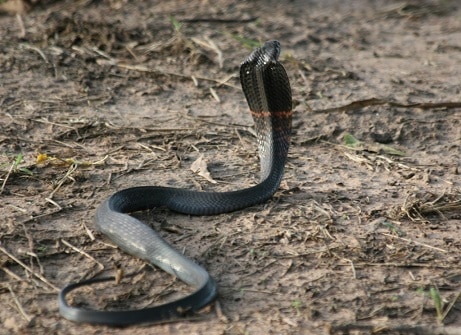
The range of the black-necked spitting cobra includes over two dozen countries. Nigeria, Ghana and southwest Kenya are just three territories where a rustling in the bushes could be followed two seconds later by an eyeful of black-neck venom.
The telltale physical characteristics of this snake include being extremely black, as you might guess. The exception is the brain-coloured pink of their bellies, which extends up to the lower chest in small stripes. Not even the most untrained eye could confuse Naja nigricollis with the Kenyan red spitting cobra or Mozambique spitting cobra. Many local Nigerians have confused them with black mambas, but the mamba is significantly lighter (and has never been sighted in Nigeria either). The forest cobra also has a black body, but its chest patches are beige and significantly larger.
Black-necked spitting cobras aren’t particularly long, measuring 1.2-2.2 metres on average, with a body of medium thickness (unlike the bulky ball python). Another telltale characteristic is bulging cheeks, where their venom glands lie hidden.
| 6 | Hides in hollow tree trunks |
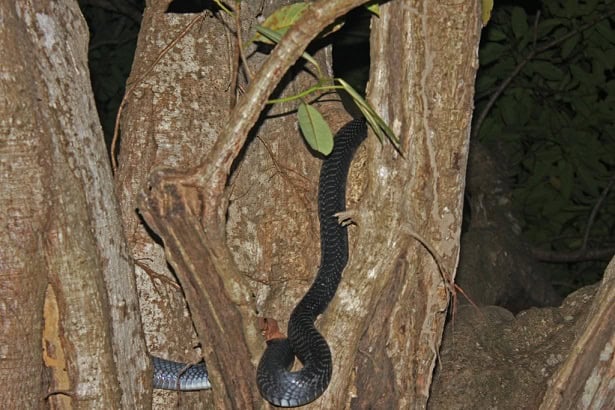
Black-necked spitting cobras share some similar hideouts with their neighbour the ball python, including termite mounds and mammal burrows. However, they’re particularly at home in crevices or hollows in tree trunks. They can also climb those trees when fleeing a predator, despite not generally living in trees.
Black-necked spitting cobras are allergic to rainforests, and they can’t cope with bone dry deserts, but everything between is fair game. The species inhabits dry savannahs, waterways, crop fields, and rocky outcrops. They’re actually growing more common in Nigeria, as the southwestern rainforests are steadily cut down and converted to a mosaic of farmland, with colonisers slithering in from the north.
Black-necked spitting cobras aren’t notorious for slithering into people’s bedrooms like the Mozambique spitter, but have a notorious attraction to chickens and their eggs. Nigerian forums are replete with reports of Naja nigricollis being bludgeoned to death as it pops up in family homesteads.
| 7 | Obscure plant remedies |
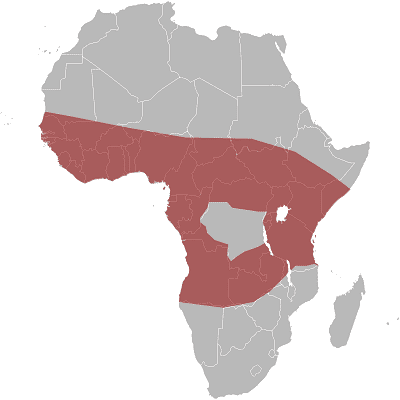
The Maasai are an African tribespeople inhabiting southwest Kenya and northeast Tanzania. According to their ancient folklore wisdom, a spitting cobra visiting a pregnant woman in her home guarantees that her firstborn will be a boy. To appease spitting cobras, the Maasai place a bowl of milk by a roaring fireplace, to provide a place of warmth. The snake never drinks the milk, but is apparently pleased by the reverence shown, and will always leave the homestead. If sprayed in the eye, the Maasai solution is to cut the ear off a sheep and instantly apply the blood.
In northern Nigeria, the Hausai and the Fulani tribes have a bevy of plant medicines used against black-necked spitting cobra bites. Two examples are Indigofera pulchra, a small branchy shrub, and Artistolochia albida, a leafy climbing plant. The tribes recommend swallowing these orally, and in 2006, they were finally proven correct.
Both plants were shown to combat the anticoagulant, hemolytic, and phospholipase dangers of Naja nigricollis venom, while other plants such as the yellow-flowered Guiera senegalense failed. Indigofera pulchra and Aristolochia albida gave 33.3% and 44.4% protection to mice injected with the venom respectively.
| 8 | Is the breast milk the secret cure? |
Milk is another traditional remedy that pops up so commonly that there may be truth to it. In 2017, Eli Greenbaum was accompanying a team of Congolese people when they met a black-necked spitting cobra. Fearless local man Maurice instantly pinned it to the floor using a long stick, but when Wendege arrived and grabbed it by the tail, he received an eyeful of venom, to his horror.
Greenbaum instantly dabbed a solution meant for cleaning scientific instruments into his eyes, and instructed him to wiggle the eyeball around. But the local Congolese men disagreed. The only solution, they argued, was a generous splashing of milk. So they tracked down a nursing mother nearby, and with no hesitation, she whipped out her breast, positioned Wendege’s head on her lap, and squeezed her milk all over the eyeball. 5 days later, Wendege had recovered, keeping his sight.
Nobody can agree on the milk question. The African Snakebite Institute says that milk has never been proven to work, and likewise for beer and urine. Villagers would argue that it’s never been proven not to work.
| 9 | Uneasy neighbours with the ball python |
As younglings, black-necked spitting cobras feed mainly on lizards. Those in Nigeria eat the common agama (Agama agama) almost exclusively, a blue, extremely common 13-30cm lizard, which in turn helps Naja nigricollis to become extremely common by providing an unlimited food supply. By adulthood, its diet mostly consists of birds and mammals.
Black-necked spitting cobras also eat other snakes, and a confirmed victim is the ball python, a thick, 100cm snake which has no venom. The two often live side by side, drawn in by the prospect of chickens and rodents living in croplands. Nigeria and Ghana are heartlands for both species.
The difference is that west African locals generally revere the ball python and rarely kill it. The ball python is believed to have been the original inhabitant of Earth when all was water, and temples or shrines are commonplace. Ball pythons are so efficient at killing pests that they’re often treated as secondary employees of farms. The black-necked spitting cobra doesn’t get 1% of this reverence, and is usually whacked to death with a shovel or iron pipe when they appear. Eating ball pythons might be purely out of jealousy.
| 10 | Split into two species |
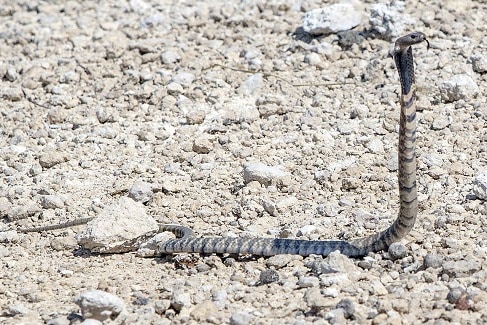
In 2007, the black-necked spitting cobra lost a large chunk of its empire when scientists concluded that those in Angola, Botswana, Namibia and South Africa were actually a separate species: Naja nigricincta. This version is covered with white stripes contrasting against the usual black, and was thus named the zebra spitting cobra. Naja nigricincta tends to prefer drier areas, even deserts within its range.
The black-necked spitting cobra was the first to be discovered back in 1843, followed by the Mozambique spitting cobra in 1854. In 1896, all African spitting cobras were lumped together under the black-neck umbrella. This over-generalisation lasted for 70 years, and when the zebra version was discovered in 1940, this too was instantly filed as a Naja nigricollis subspecies.
In 1968, the Mozambique spitting cobra was finally reinstated as a full species, and Naja nigricincta became one of its subspecies. In 1974, Naja nigricincta was transferred back to being a black-neck subspecies, until 2007, when genetic analysis proved it to be an independent species once and for all.
| 11 | Their bite is just as bad |
In 1965, scientists decided to place some toads in the cages of Egyptian cobras. The snakes rarely took notice instantly, and when they did, they roamed around the cage clumsily until they simply bumped into the toad. They they would hesitantly deliver a bite and hold on until their prey died.
Meanwhile, the black-necked spitting cobra raised its head instantly when the toad appeared, and made a forceful and determined lunge. The toad was bitten multiple times until it finally gave in. The scientists concluded that “Naja haje is less alert than Naja nigricollis where food is concerned”.
A black-neck’s bite wound is just as worrying as an eyeful of venom, as Naja nigricollis has a venom yield of 200-350mg, beating the boomslang at 1.6-8mg with ease, although the LD50 rating is significantly weaker at 1.15-2mg (compared to 0.07mg). It’s mainly a cytotoxic venom, corroding and blackening once healthy skin cells, and also delivers cardiotoxins and anticoagulants that cause bleeding from every minor cut. Like the Mozambique spitting cobra, the main class of toxins is the cytotoxin PLA2.
| 12 | Comparison: forest cobra |
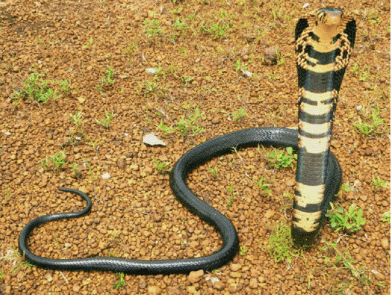
In Nigeria and surrounding countries like Ghana, there are two resident cobras. There’s the 2-2.5 metre forest cobra, with an occasionally bright yellow chest marking, and the 1.5-2 metre black-necked spitting cobra.
Clearly, the two must find a way to coexist without constantly stealing each other’s resources. In a 2002 study, scientists revealed the exact habitat differences between them. They marched around the Nigerian wild, scooping up cobras wherever they could find them. The results were unambiguous:
- Of the 142 forest cobras captured, 47.9% were in mature forests, versus just 6.0% of the black spitting cobras captured.
- Of the 184 black-necks captured, 52.2% were in suburbia, residential areas of towns, versus just 9.2% for the forest cobra.
Both inhabited “mosaic” landscapes about 40% of the time, mixed grassland, farmland and tree clumps. The black-necked spitting cobra is clearly way more comfortable with areas modified by mankind’s unstoppable spread. This has caused its numbers to balloon in past decades, as Nigeria has lost its forest cover to farmland and towns. With forest cobras, it’s the opposite. They were originally the more common of the two, but have seen steep declines.
